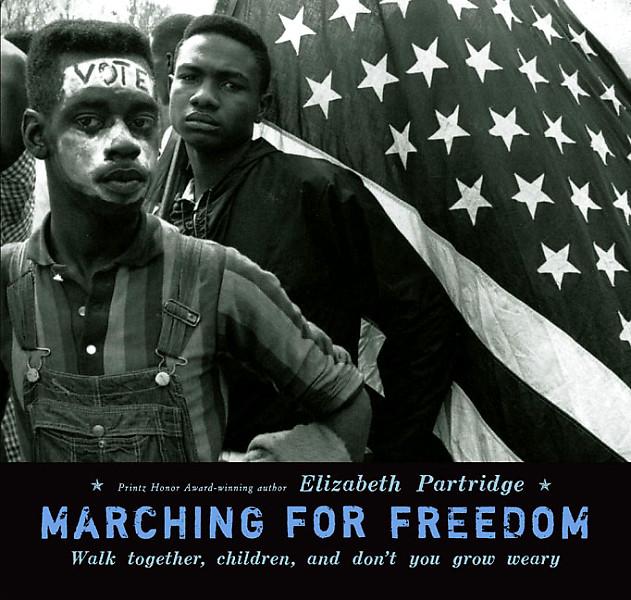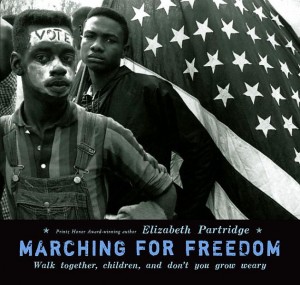22 Jan / Marching for Freedom: Walk Together, Children, and Don’t You Grow Weary by Elizabeth Partridge

 Once upon a time not so long ago, Americans were willing to risk their very lives for the privilege to cast their votes. Since the 1970s, just over half of U.S. citizens eligible to vote have turned out for Presidential elections (with the exception of the historical 2008 election with 63% voter turnout). Far fewer bother to show up for non-Presidential elections. Sad state of affairs indeed.
Once upon a time not so long ago, Americans were willing to risk their very lives for the privilege to cast their votes. Since the 1970s, just over half of U.S. citizens eligible to vote have turned out for Presidential elections (with the exception of the historical 2008 election with 63% voter turnout). Far fewer bother to show up for non-Presidential elections. Sad state of affairs indeed.
But back in 1965, hundreds of African American citizens of Selma, Alabama gathered together to fight for the right to have their voices officially heard. In Selma, more than half of the 30,000 residents were African American, but 99% of the registered voters were white. “The Alabama governor, George Wallace,” reports Elizabeth Partridge, “made sure [voter registration for black voters] was virtually impossible. He actively promoted use of an unfairly administered ‘literacy test.’ Rigged for failure, the test was a series of unreasonable questions about the Constitution and obscure laws.” White voters faced no such obstacles.
Inspired by the fiery young Martin Luther King, Jr., Selma’s residents, especially young African American students who were still too young to vote, decided to organize a march to fight for fair access to the voting booth. They were abused and arrested again and again – even young children – but still they would not stop. On March 7, 1965, which would be known as Bloody Sunday, Alabama State Troopers attacked a nonviolent marching crowd with tear gas and billy clubs. “‘We were going to get killed or we were going to get free,’ said one marcher.” The horrific melee was caught by news cameras and broadcast nationally: “Forty-eight million viewers watched in growing disbelief and horror as men, women, and children desperately fled for safety.”
Fueled by MLK’s leadership, the people refused to give up. They were buoyed by President Lyndon Johnson who promised much needed reform in a live televised broadcast on March 15: “‘Their cause must be our cause too. It is not just Negroes, but all of us, who must overcome the crippling legacy of bigotry and injustice. And we shall overcome.‘” Six days later, hundreds of Americans, both black and white, began a historic 54-mile march from Selma to Montgomery, protected the U.S. Army sent by President Johnson. Despite challenging conditions, the hundreds grew to thousands by the time they reached their goal, the Capitol Building in Montgomery, on March 25, where Rosa Parks and MLK were waiting to share their triumph.
Less than five months later, President Johnson signed the Voting Rights Act into law on August 6, 1965. Selma residents, especially the youth, had paved the way. “Hundreds of students had put themselves at risk to change America’s voting laws. Their idealism and bravery encouraged the adults. Together, they learned to live with fear, but did not let it stop them. With only their songs and faith for protection, they believed they could make a difference. And they did.”
Marching for Freedom is an unforgettable testament to the power of youthful change. Award-wining author Partridge has pieced together the story from books, articles, and most importantly interviews with actual participants of the historic march, and enhanced the words with stark images of horrific violence juxtaposed with determined hope. Freedom captures a moment of history that should shake us out of our inexcusable malaise, and keep driving us to the polls every time we’re called upon to participate. Imagine … if we don’t use it, we could very well lose it.
Readers: Middle Grade
Published: 2009
